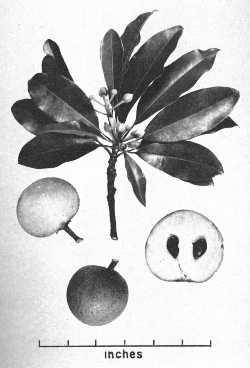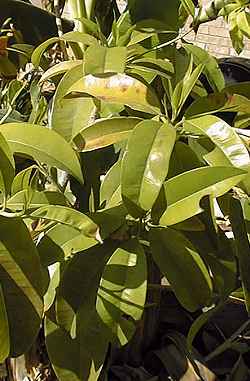Sapodilla, Nispero
Scientific Name: Manilkara zapota (L.) P. Royen
Synonym: Manilcara achras, Sapota achras
Family: Sapotaceae
Sunset®: 23, 24
USDA: 10
Frost Tolerance: Semi tender in Phoenix, foliage damaged at 30° F (-1° C), serious damage at 26° F (-3° C)
Sun Exposure: Full sun
Origin: Tropical forests of Central America
Growth Habits: Evergreen tree to 60 feet (18m)
Watering Needs: Regular water
Propagation: Seeds, grafting, budding, marcottage

The Sapodilla, a very common tropical American fruit produces attractive evergreen trees that often reach a height of 60 feet or more. In southern Mexico, this species is tapped for its ingredient of chewing gum. The elliptic to obovate leaves are 2 to 5 inches long (5 to 8 cm) and 1 to 2 inches wide (2.5 to 5 cm).
Two varieties, Prolific and Russell, have been selected and named from Florida, where additional evaluations of clonal selections have been made. There seems to be a seedless form in Cuba, propagated by grafting.
Blooming Habits:
The inconspicuous flowers are borne in the leaf axils and are produced over a long season, so that ripe fruit may be found most of the year.
Fruiting Habits:
Fruits usually are 2 to 4 inches in diameter (5 to 10 cm) and vary from globose to ovoid. The thin skin is grayish or rusty brown. The yellowish brown flesh is tender and of delicious flavor. The hard black seeds vary from none to 6 or 12 and are easily separated from the pulp.
Culture:
In the tropics, fruits of the sapodilla are often attacked by both the Mediterranean and Mexican fruitflies, rendering them unfit for consumption.
Propagation:
The sapodilla usually is propagated by seeds which require 4 to 5 weeks to germinate. It can also be grafted or budded.
Desert-Tropicals is dedicated to provide gardening advice, gardening ideas, and information about flower of all kind for landscape and collections.We try to check carefully the identification of the plants on the illustrations as well as the other information from the page, but occasionally errors do occur. if you notice anything that needs to be changed please contact us.Thanks.
© 1998-2020 Philippe Faucon, All Rights Reserved.
